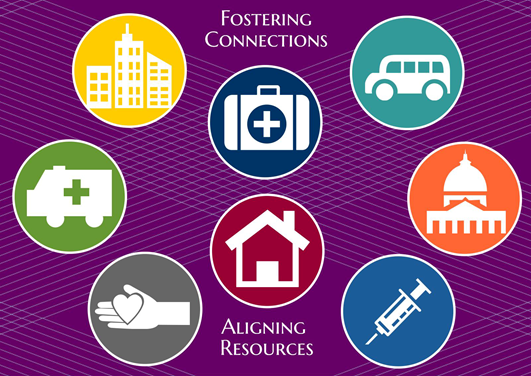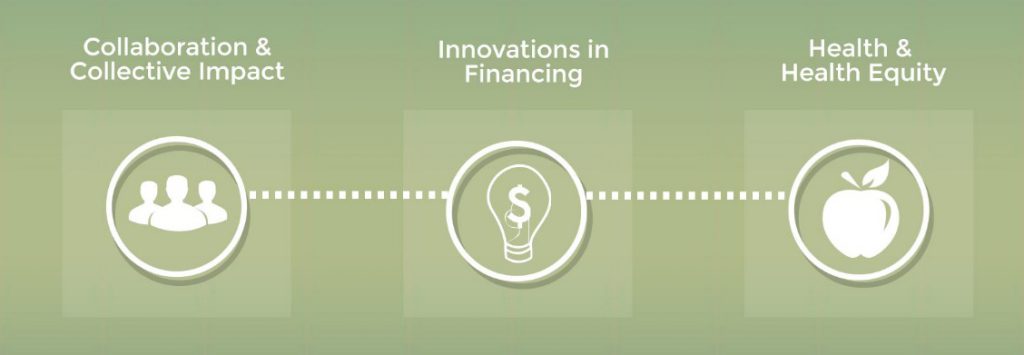By Karen Minyard, PhD, Executive Director, Georgia Health Policy Center
 The good news is that communities across the nation are doing the hard work to develop ambitious plans to change their local health system to foster improvements in their community’s health. Tackling influencers of wellness that fall outside of the scope of the traditional health care delivery system is not only hard work, but it requires dedication and creativity. There is no simple formula that adding new players and more money equals instant improvements in community health. Each community’s demographics and needs may require new innovations or tweaking initiatives to the local context.
The good news is that communities across the nation are doing the hard work to develop ambitious plans to change their local health system to foster improvements in their community’s health. Tackling influencers of wellness that fall outside of the scope of the traditional health care delivery system is not only hard work, but it requires dedication and creativity. There is no simple formula that adding new players and more money equals instant improvements in community health. Each community’s demographics and needs may require new innovations or tweaking initiatives to the local context.
Just as many factors contribute to local health disparities, it takes many partners to come together to work towards health equity. Newfound partnerships between public health departments and other community organizations offer an exciting opportunity to jointly improve population health.

Many national efforts are underway to encourage communities to explore novel mechanisms to fund initiatives targeting the upstream drivers of health and wellness. Bridging for Health: Improving Community Health Through Innovations in Financing, supported by the Robert Wood Johnson Foundation and coordinated by the Georgia Health Policy Center, is one of these initiatives that takes a systemic approach to improving population health.
Bridging for Health fosters connections among diverse stakeholders to align investments to target the upstream drivers of health that will ultimately improve population health outcomes. Encompassing many of the core principles Dr. DeSalvo laid out in the launch of Public Health 3.0, Bridging for Health works with communities on the linkages between three key areas—innovations in financing, collaboration, and health equity—in order to build healthy, sustainable, thriving communities.

There is widespread consensus that improving conditions around non-traditional drivers of health—education, economic development, housing, and access to food—can improve wellness. The question becomes, “How do we pay for these initiatives?” Budgets are tight across all sectors, so stakeholders must be creative.
Bridging for Health is aiding communities in developing and implementing financing mechanisms, such as wellness trusts, capture and reinvestment, and pay for success models. There is no one mechanism that will meet the needs of all communities. Participating communities bring the creativity, passion, energy, and commitment to innovate. Financing innovations may include implementing a known innovation in a new setting, combining innovations in new ways, or creating new financing vehicles to meet local context.
While communities are excited to think about innovating, financing mechanisms are not magic bullets. Money alone cannot single handedly tackle inequities and transform population health. A successful financing initiative requires the right partners and a common vision to bring about big change. By bridging connections between multisector stakeholders, including health care providers, public health, social services, businesses, schools, housing, transportation, and community development, Bridging for Health aims to align resources and community efforts. By promoting good stewardship, community partners can enhance planning and management of health-related resources.
Bridging for Health initially selected four geographically diverse sites. The sites differ in the leadership of the collaborative and financing mechanism being explored, but share a commitment to upstream investment in interventions to improve population health outcomes in their community.
We invite you to meet these four innovator communities and follow them on their journeys of Bridging for Health.
- Yamhill Community Care Organization in Oregon
- Allegheny County Health Department in Pennsylvania
- Bexar County Health Collaborative in San Antonio, Texas
- Spartanburg’s Way to Wellville in South Carolina
Over the next year, we will be adding additional sites. If you know of an on-the-ground partnership of community leaders and health partners that are jointly innovating ways to finance population health, we’d love to meet them. Please visit us online at www.ghpc.gsu.edu/bridging or email us at bridging@gsu.edu.